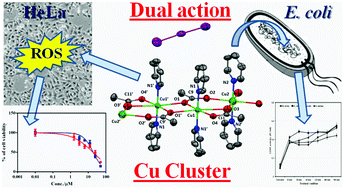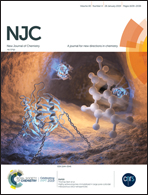Synthesis of a new acetate bridged Cu(ii) building block generated 1D polymer and studies on structural, magnetic, antibacterial and anticancer properties†
Abstract
A new [Cu3(Py)6(μ-CH3COO)4(I3)2]n (1) 1D polymer has been obtained from the mixture of Cu(NO3)2·3H2O, Mn(CH3COO)2·4H2O and solid I2 in CH3COOH/pyridine (py). The asymmetric unit 1 has the formula {[Cu0.75(OAc)1(pyridine)1.5]·(I3)0.5}n with Z = 2 and it has two Cu atoms, Cu1 on a mirror plane and Cu2 at a site with crystallographically imposed 2/m symmetry where the two acetate groups lie on a mirror plane; one pyridine ring in a general position is bonded to Cu1, while the other pyridine ring lies about a twofold axis and is bonded to Cu2. All C5H5N groups are involved in π–π stacking interactions with those on neighboring Cu3 molecules to give a 1D polymeric supramolecular network resembling a metal–organic framework (MOF) with periodic voids resulting from a repeating unit consisting of [Cu3]n. Magnetic susceptibility studies in the 5.0–300 K temperature range in a 0.1 T (333 Hz) direct current (dc) magnetic field revealed the presence of weak antiferromagnetic intra-Cu3 exchange couplings. The ground state spin (S) value calculated for 1 is S = 1/2. Alternating current magnetic susceptibility studies showed that the single-molecule magnet (SMM) behavior characteristic of 1 has been lost. The cluster 1 showed antimicrobial activity on different bacteria viz. Gram positive bacteria (Bacillus cereus MTCC1272, Staphylococcus epidermidis MTCC 3086 and Enterococcus faecalis MCC 2041(T)) and Gram negative bacteria (Salmonella enterica var Typhimurium MTCC 98 and E. coli MTCC 723). The highest significant growth inhibition zone (28.0 ± 1.34 mm) for the organisms was observed in E. faecalis MCC 2041(T) in the presence of 1 which was further confirmed by time kill assay and time kill endpoints activity. Cluster 1 was also found to induce apoptotic cell damage via generation of reactive oxygen species (ROS) when studied in human cervical cancer cells (HeLa) and human breast adenocarcinoma cells (MCF7), showing IC50 values 18.54 ± 0.09 μM and 19.21 ± 0.15 μM, respectively.



 Please wait while we load your content...
Please wait while we load your content...